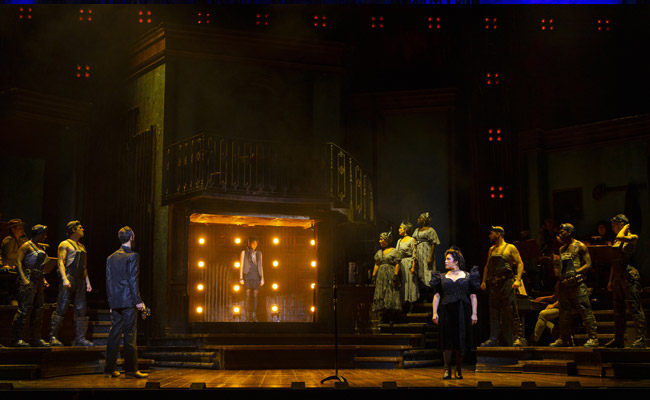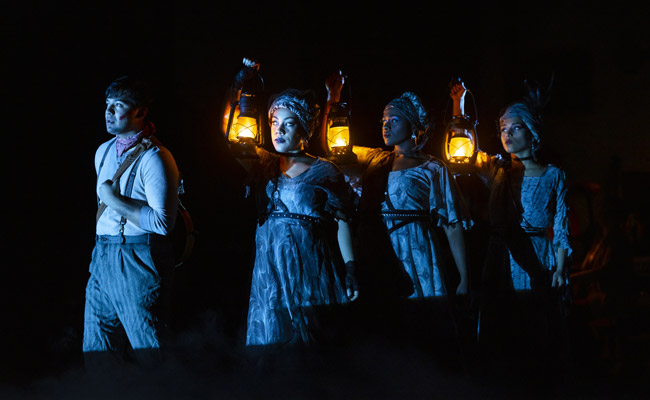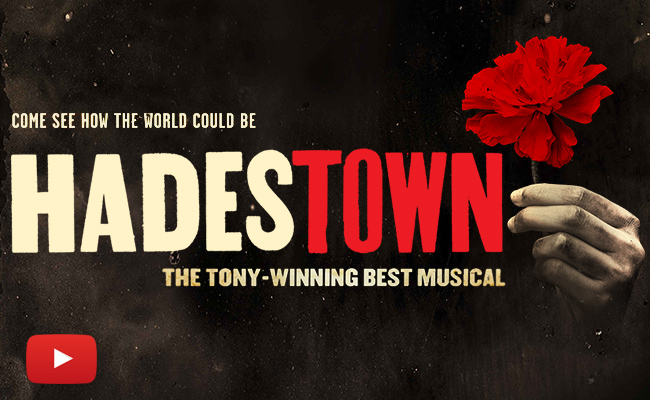
T. Charles Erikson
The hit, Tony Award-winning Broadway musical Hadestown is touring North America (the tour actually started in 2021 with a different cast — as seen in the promotional video below — including Nicholas Barasch, who is now appearing on Riverdale as Julian Blossom), and this is now my second time seeing it, which I was more than happy to do. Before seeing it the first time, all I really know about it was that it won the Tony Award for Best Musical and that Baltimore native André De Shields won for Best Actor in a Featured Role in a Musical. And I also assumed it might have something to do with Hell based on the title and the performance presented on the Tony Awards. What I was surprised to learn was that the story is actually taken from Greek mythology, two stories in fact, featuring Orpheus & Eurydice and Hades & Persephone (and the classic 1950 Jean Cocteau film Orpheus is a favorite of mine, so look it up).
Entering the theatre, the audience is greeted with the sight of what appears to be a café, or a speakeasy as it is described in the official materials, in some indeterminate world and some indeterminate time that very well could be an alternate universe version of New Orleans. Hermes (Nathan Lee Graham) introduces the players in the story with the song ‘Road to Hell’, and we quickly learn about Orpheus (J. Antonio Rodriguez), who works at the speakeasy; Eurydice (Hannah Whitley), who wanders in seeking food and shelter from the bleak Winter outside; The Fates (Dominique Kempf, Belén Moyano, Nyla Watson), who can’t help but interfere in everyone’s business, always talking in the back of your head; the Workers — Jordan Bollwerk, Jamal Lee Harris (Sean Watkinson filled in for Harris at our performance), Courtney Lauster, Shavey Brown, Racquel Williams — who function as a Greek chorus (the hardest working Chorus, according to Hermes; Persephone (Maria-Christina Oliveras), who brings the warmth of Spring and Summer to the world; and Hades (Matthew Patrick Quinn), the King of the Underworld himself. Despite Hermes’ suggestion not to be rash when speaking to Eurydice, Orpheus can’t help but ask her to come home with him … because they’re going to be married. First words out of the kid’s mouth. Persephone arrives and things change for the better, and Eurydice finds herself quickly — very quickly — falling in love with Orpheus, who has been struggling to finish writing a song. But Hades come to collect Persephone earlier than expected, plunging the world back into the depths of Winter.

T. Charles Erikson
As food becomes scarce again, and with Orpheus laser focused on finishing his song to make Spring come again, Eurydice goes to seek out food but is tempted by The Fates and King Hades to board the train to Hadestown where she won’t have to worry about food or the cold. She calls out to Orpheus, but he doesn’t answer, so she bids him farewell and travels to Hadestown. There she finds it’s not all as promised — Persephone also discovers the changes Hades has made to the place including a foundry and an electrical grid — and she is quickly assimilated into the group of workers, her memories of who she is and where she came from quickly fading away. Orpheus discovers what Eurydice has done and Hermes tells him the only way for him to get to Hadestown without a ticket is to walk … and he does, begging Hades to let Eurydice return home with him. But she’s signed a contract, made a deal with the Devil if you will, and even with Persephone strongly suggesting he let the two lovers depart, Hades isn’t sure he can — if he does, he will appear weak and if he doesn’t, they will become martyrs. Hades allows Orpheus to sing his song and strikes a deal: they can leave but Orpheus has to lead and if he looks back to see if Eurydice is following, she is immediately banished to Hadestown forever. Is it an offer they can’t refuse? And will Orpheus be able to trudge from the Underworld, a long and treacherous trip, without looking back? Or is it all a trick?
Upon my first visit to Hadestown, it took me a while to warm up to the story but the song ‘When the Chips Are Down’ really grabbed me and pulled me on board. This time, being a bit more familiar with the story and the music, I was much more easily invested in all of it, made all the more easy with the outstanding performances of the five leads, the three Fates, the Chorus and the excellent musicians on stage. Nathan Lee Graham’s Hermes serves as Orpheus’ mentor of sorts — he was friends with Orpheus’ mother, who was also a Fate — and as our narrator, commenting on the goings-on sometimes with humor and joy, sometimes with menace and sadness. Maria-Christina Oliveras is Persephone (taking over for Lana Gordon in the earlier production), a benevolent god who brings everyone in the speakeasy food and wine … lots of wine. She also gets to really cut up in the Act II opening number ‘Our Lady of the Underground’, and she brings a lot of layers to the character, torn between her love of Hades and her love for the people above ground. I really liked Gordon in the role, but Oliveras is having fun and makes it her own. J. Antonio Rodriguez brings a sweet innocence to Orpheus, and has a killer falsetto when he sings, which is a complete contrast to Matthew Patrick Quinn’s Hades, who menaces the others with his deep, booming voice (reminiscent of the How the Grinch Stole Christmas singer Thurl Ravenscroft). Hannah Whitley is also outstanding as Eurydice, also bringing many layers to the character as she goes from just a girl who wanders in, to falling in love, and making a choice for her own survival. I do have to say I felt a completely different energy at this performance than I did in Baltimore — not that there was anything wrong with that one — but at this DC show the cast was hitting it on every level, making it a truly electrifying and emotional experience (to the point I had actual tears rolling down my face at the end).
The five cast members who play the Workers are always there to happily sing along, but once they become workers in the new foundry in Hadestown, they are more downtrodden with a lot of physical choreography (this show puts the cast through their paces, literally, with a turntable stage that allows them to keep walking without moving across the set). My favorite characters though are The Fates, always tempting the characters with this-or-that scenarios. All three actresses were terrific, but I could not take my eyes off of Dominique Kempf. The way she moved, how she would sharply punctuate a moment with her shoulders, the way she could switch her facial expressions from happy to threatening or judgmental or just plain bitchy and then right back into a happy smile had me mesmerized the first time I saw the show, and nothing has changed this time around. All three of the actresses including Belén Moyano and Nyla Watson were excellent, with great harmony. It was their performance of ‘When the Chips Are Down’ that originally won me over, and I just looked forward to ever number in which they performed front and center.

T. Charles Erikson
Also mesmerizing is the production design which is fairly simple — a single set featuring the band on stage, acting as part of the story, an upper balcony, and a wall that opens when the Hadestown train arrives or departs. There are a couple of surprises built in to the set as well and it was all magnificent. The lighting design was gorgeous, particularly in the use of colors like the reddish-orange that bathed the stage when Hades sang, or the blue-greens for Persephone as a contrast. Really some beautiful work by Rachel Hauck and Bradley King, respectively, and the ‘Wait For Me’ number with the swinging lights was fascinating. The costume design by Michael Krass was also terrific, mixing many different eras from the plantation worker-meets-jazz baby looks of The Fates, to the Prohibition era outfits worn by Hades and Persephone, to Hermes’ silver suit, to the thrift store looks of Eurydice and Orpheus. to the casual streetwear and heavy leather overalls worn by the Chorus above and below ground. Really great work that has a lot of visceral impact.
The direction and staging of the show is a bit different, from what I’m told, from the Broadway production due to the limitations of a traveling show, but it’s no less impactful and the use of the turntable really adds a lot to it, reminiscent of the turntable used in Hamilton and the original production of Les Misérables. Director Rachel Chavkin truly earned her Tony Award for direction, keeping the story moving but allowing those moments for the characters to pause for the emotional impact the audience needs to feel. The sound design was great, no one was ever drowned out by the music (although I’m not sure why the mics were off during the curtain call song — but it must be a thing since it was like that in both productions). The Tony-winning music & lyrics, and the Tony-nominated book by Anaïs Mitchell is just stunning. The two stories are interwoven expertly, and the songs are fantastic at being as integral to the story as is the dialogue. Put all of this together and it’s hard to resist hitting the road to Hadestown, no matter how many times you’ve seen it.
Hadestown runs about 2 hours 30 minutes with one intermission. Recommended for ages 8 and up.
Hadestown runs through June 18 at Washington DC’s National Theatre. Other cities on the schedule include Chicago, Toronto, Ottowa, San Francisco, Sacramento, Los Angeles, Seattle, Norfolk, Indianapolis, Philadelphia, Boston and more. Visit the official website for more information. Use our Ticketmaster link to purchase tickets.
Hadestown – National Tour Trailer


